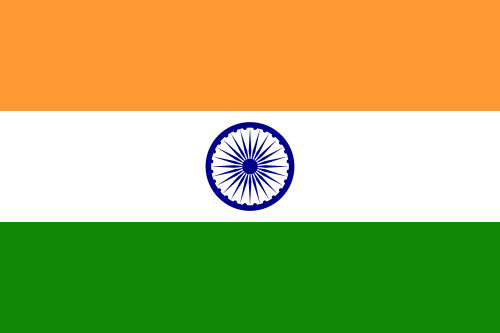
Country Flags by Continent
|
|
The National Flag of India is a horizontal rectangular tricolour of deep saffron, white and India green; with the Ashoka Chakra, a 24-spoke wheel, in blue at its centre. It was adopted in its present form during a meeting of the Constituent Assembly held on 22 July 1947, when it became the official flag of the Dominion of India. The flag was subsequently retained as that of the Republic of India. In India, the term "tricolour" almost always refers to the Indian national flag. The flag is based on the Swaraj flag, a flag of the Indian National Congress designed by Pingali Venkayya.
The flag, by law, is to be made of khadi, a special type of hand-spun cloth of cotton or silk made popular by Mahatma Gandhi. The manufacturing process and specifications for the flag are laid out by the Bureau of Indian Standards. The right to manufacture the flag is held by the Khadi Development and Village Industries Commission, who allocate it to the regional groups. As of 2009, the Karnataka Khadi Gramodyoga Samyukta Sangha was the sole manufacturer of the flag.
Usage of the flag is governed by the Flag Code of India and other laws relating to the national emblems. The original code prohibited use of the flag by private citizens except on national days such as the Independence day and the Republic Day. In 2002, on hearing an appeal from a private citizen, the Supreme Court of India directed the Government of India to amend the code to allow flag usage by private citizens. Subsequently, the Union Cabinet of India amended the code to allow limited usage. The code was amended once more in 2005 to allow some additional use including adaptations on certain forms of clothing. The flag code also governs the protocol of flying the flag and its use in conjunction with other national and non-national flags.
Design and symbolism
Gandhi first proposed a flag to the Indian National Congress in 1921. The flag was designed by Pingali Venkayya, an agriculturist from Machilipatnam. The original design Gandhi was presented with included two colours, red for the Hindus, and green for the Muslims. In the centre was a traditional spinning wheel, symbolising Gandhi's goal of making Indians self-reliant by fabricating their own clothing. The design was then modified to include a white stripe in the centre for other religious communities, and provide a background for the spinning wheel. Subsequently, to avoid sectarian associations with the colour scheme, saffron, white and green were chosen for the three bands, representing courage and sacrifice, peace and truth, and faith and chivalry respectively.
A few days before India became independent on August 1947, the specially constituted Constituent Assembly decided that the flag of India must be acceptable to all parties and communities. A modified version of the Swaraj flag was chosen; the tricolour remained the same saffron, white and green. However, the charkha was replaced by the Ashoka Chakra representing the eternal wheel of law. Sarvepalli Radhakrishnan, who later became India's first Vice President, clarified the adopted flag and described its significance as follows:
“ Bhagwa or the saffron colour denotes renunciation or disinterestedness. Our leaders must be indifferent to material gains and dedicate themselves to their work. The white in the centre is light, the path of truth to guide our conduct. The green shows our relation to (the) soil, our relation to the plant life here, on which all other life depends. The "Ashoka Chakra" in the centre of the white is the wheel of the law of dharma. Truth or satya, dharma or virtue ought to be the controlling principle of those who work under this flag. Again, the wheel denotes motion. There is death in stagnation. There is life in movement. India should no more resist change, it must move and go forward. The wheel represents the dynamism of a peaceful change" |

